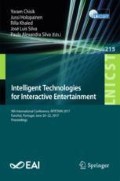Abstract
Animal incorporated games were both hypothesized and shown to serve multiple desired objectives, among which improvement of animal welfare, strengthening pet-owner relations, and creating new experiences for human players. We study the expected player experience of animal incorporated games through the use of an extended survey (n = 177). Our results indicate that respondents expect (a) added unpredictability caused by animal-opponent behavior, (b) increased enjoyment when playing against animals, for a limited duration of time, and (c) that hypothetical exact simulation of animal behavior offers equally interesting opponent behavior. Furthermore, concerns of animal welfare significantly moderate the preference for computer-, exact simulated- or animal-opponents. These outcomes can be used to correct for aspects such as novelty bias, when measuring player experiences in animal incorporated type games.
Access this chapter
Tax calculation will be finalised at checkout
Purchases are for personal use only
Notes
- 1.
- 2.
As one respondent indicated on the survey, “I do not like crickets!”.
References
Riedel-Kruse, I.H., Chung, A.M., Dura, B., Hamilton, A.L., Lee, B.C.: Design, engineering and utility of biotic games. Lab Chip 11(1), 14–22 (2011). https://doi.org/10.1039/C0LC00399A
Purina Friskies: Games for Cats (2011). https://www.gamesforcats.com
Wilson, S.: Protozoa Games (2003). http://userwww.sfsu.edu/swilson/art/protozoagames/protogames10.html
Geurtsen, A., Lamers, M.H., Schaaf, M.J.M.: Interactive digital gameplay can lower stress hormone levels in home alone dogs—a case for animal welfare informatics. In: Chorianopoulos, K., Divitini, M., Hauge, J.B., Jaccheri, L., Malaka, R. (eds.) ICEC 2015. LNCS, vol. 9353, pp. 238–251. Springer, Cham (2015). https://doi.org/10.1007/978-3-319-24589-8_18
van Eck, W., Lamers, M.H.: Animal controlled computer games: playing Pac-Man against real crickets. In: Harper, R., Rauterberg, M., Combetto, M. (eds.) ICEC 2006. LNCS, vol. 4161, pp. 31–36. Springer, Heidelberg (2006). https://doi.org/10.1007/11872320_4
van Eck, W., Lamers, M.H.: Biological content generation: evolving game terrains through living organisms. In: Johnson, C., Carballal, A., Correia, J. (eds.) EvoMUSART 2015. LNCS, vol. 9027, pp. 224–235. Springer, Cham (2015). https://doi.org/10.1007/978-3-319-16498-4_20
Fagen, R.: Animal Play Behaviour. Oxford University Press, New York (1981)
Smith, P.K.: Play in Animals and Humans. Blackwell Pub, Oxford (1986)
Mancini, C.: Animal-computer interaction: a manifesto. Interactions 18(4), 69–73 (2011). https://doi.org/10.1145/1978822.1978836
Noz, F., An, J.: Cat cat revolution: an interspecies gaming experience. In: Proceedings of SIGCHI Conference on Human Factors in Computing Systems, pp. 2661–2664 (2011). https://doi.org/10.1145/1978942.1979331
Tan, R.T.K.C., Cheok, A.D., Peiris, R., Todorovic, V., Loi, H.C., Loh, C.W., Derek, T.B.S.: Metazoa ludens: mixed reality interactions and play for small pets and humans. Leonardo 41(3), 308–309 (2008). https://doi.org/10.1162/leon.2008.41.3.308
Westerlaken, M., Stefano G.: Felino: the philosophical practice of making an interspecies videogame. In: The Philosophy of Computer Games Conference, pp. 1–12 (2014)
Alfrink, K., van Peer, I., Lagerweij, H., Driessen, C., Bracke, M.: Playing with Pigs (2012). http://www.playingwithpigs.nl
Wirman, H.: Games for/with strangers-captive orangutan (pongo pygmaeus) touch screen play. Antennae 30, 105–115 (2014)
Extra Pop.: Games for dogs (2015). http://www.bicshare.com
Baskin, S., Zamansky, A., Kononova, V.: Exploring human perceptions of dog tablet playful interactions. In: Proceedings of Third International Conference on Animal-Computer Interaction (2016). https://doi.org/10.1145/2995257.3012023
Youtube: African Bull Frog ant crusher (2011). youtu.be/WlEzvdlYRes
Lee, S.A., Bumbacher, E., Chung, A.M., Cira, N., Walker, B., Park, J.Y., Starr, B., Blikstein, P., Riedel-Kruse, I.H.: Trap it!: a playful human-biology interaction for a museum installation. In: Proceedings of 33rd Annual ACM Conference on Human Factors in Computing Systems (2015). https://doi.org/10.1145/2702123.2702220
Youtube: Fish plays Pokemon: pallet town syndrome (2014). youtu.be/48-qOC4fCdk
Young, D.: Lumberjacked (2005). http://classic.rhizome.org/artbase/artwork/35526
Weibel, D., Wissmath, B., Habegger, S., Steiner, Y., Groner, R.: Playing online games against computer- vs. human-controlled opponents: effects on presence, flow, and enjoyment. Comput. Hum. Behav. 24(5), 2274–2291 (2008). https://doi.org/10.1016/j.chb.2007.11.002
Rouse, R.: Game Design: Theory and Practice, 2nd edn. Jones and Barlett Publishers, Sudbury (2005)
Mancini, C., Zamansky, A.: Charting unconquered territories: intelligent systems for animal welfare. In: 40th Annual Convention of the Society for the Study of Artificial Intelligence and the Simulation of Behaviour, pp. 181–182 (2014)
Harvey, H., Havard, M., Magnus, D., Cho, M.K., Riedel-Kruse, I.H.: Innocent fun or ‘microslavery’. Hastings Cent. Rep. 44(6), 38–46 (2014). https://doi.org/10.1002/hast.386
Author information
Authors and Affiliations
Corresponding author
Editor information
Editors and Affiliations
Rights and permissions
Copyright information
© 2018 ICST Institute for Computer Sciences, Social Informatics and Telecommunications Engineering
About this paper
Cite this paper
van Eck, W., Lamers, M.H. (2018). Player Expectations of Animal Incorporated Computer Games. In: Chisik, Y., Holopainen, J., Khaled, R., Luis Silva, J., Alexandra Silva, P. (eds) Intelligent Technologies for Interactive Entertainment. INTETAIN 2017. Lecture Notes of the Institute for Computer Sciences, Social Informatics and Telecommunications Engineering, vol 215. Springer, Cham. https://doi.org/10.1007/978-3-319-73062-2_1
Download citation
DOI: https://doi.org/10.1007/978-3-319-73062-2_1
Published:
Publisher Name: Springer, Cham
Print ISBN: 978-3-319-73061-5
Online ISBN: 978-3-319-73062-2
eBook Packages: Computer ScienceComputer Science (R0)

